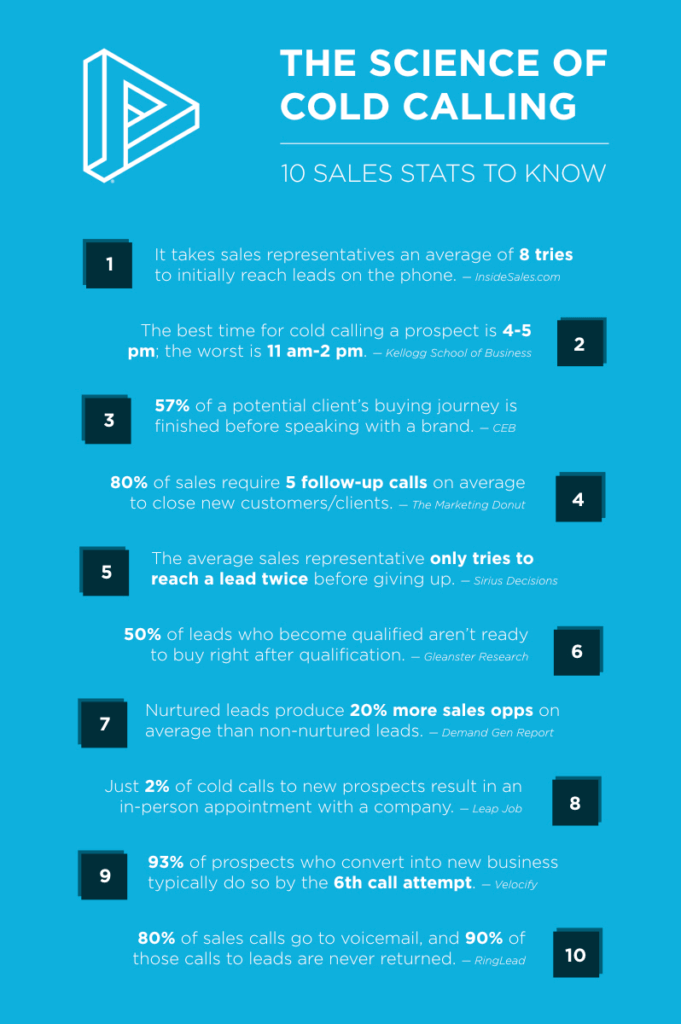What is Cold Calling?
Cold calling techniques are used to make contact with potential customers by phone. The art of cold calling is still an effective way to grow your customer base and reach new people that may not have been introduced to your company before.
It’s been used as a method of lead generation for years and it is still one of the most effective ways to sell your company’s products or services.
12 Cold Calling Techniques and Tips
There are twelve cold calling techniques that really work and cold call tips that have been proven to be effective for reaching potential customers.
1 Strong research skills
An effective salesperson needs to be making sales cold calls to the right person at the right time. To utilize their time in the most efficient way possible, a good salesperson will use market research, focus on their target market, and get as much background on the decision-maker upfront.
Connecting with the right person (the first time) can be a critical component of your cold calling success. Dig into the background of the company, the person you’re pitching to, and the industry in general.
With great research skills, you will be able to connect with the right person at the right time.

Source: pexels.com
2 Leverage social media
A good salesperson will leverage social media to find current and potential clients for cold calling sales.
Start with the basics: know who you’re talking to, what they want, and how you can give it to them.
The first step on how to make a cold call is knowing who your target audience is and understanding their needs. What do they need? How can you help them?
3 Plan a great opening and lead the conversation
When you’re cold calling businesses, the first few minutes of your conversation matter a lot.
Plan out what you want to say and come up with an opening question for cold call sales that will lead the person you’re speaking to down a path where they see the value in engaging further. The best way to cold call is usually asking open ended questions about their business.
Know what you want to say if they ask “why are you calling?”
If the person on the other line asks this question, it usually means that your opening didn’t go well and they don’t see value in continuing a conversation with you. They could also be suspicious of your intentions (either because they’ve been called by solicitors, or are in a high-pressure sales environment where this is an icebreaker).
Your response needs to be clear: give them the specific value that you have to offer and why it will work for them. Never say “I want your business.”
4 Be prepared: The script
You should memorize your script before you start to have successful cold calls.
A script is a set of lines that have been written out and practiced to make the sales cold call go smoothly without any pauses for thought or hesitation. It’s not like every salesperson has their own individual script, but it can help with some points they want to cover during the conversation such as a feature of the product.
It should cover three parts: an introduction, a summary, and a close.
The intro is to let them know who you are as well as what your company does. The summary will be to provide information on how it can help their business (with features or benefits). Finally, the closure will leave things open for response and ask for the meeting.
Make sure your script does not go over two or three sentences, otherwise they won’t pay attention to you and will hang up before the call for sales ends.
5 Pick the right time
The best time to talk is when they are most likely at their desk and not busy with anything else so that your voice will be the only thing they are focused on.
If you want them to take you seriously, don’t make cold call seem like a sales pitch where there is no room for negotiation or discussion because this makes people defensive.
Don’t be too aggressive or intimidating. Leave a lot of space for discussion and negotiation at the end of your call so that there is room to go back on any decision made during the call. Remember, you want them to buy from you not just agree with what you say.
It is important to sound confident but also to give them a chance to talk and be heard. This will make the conversation feel less one-sided.
6 Know how to deal with common objections
One of the most important tips for cold calling is to have a good understanding of your product or service. People don’t buy what they can’t understand, and if you sound confident in something that doesn’t make sense to them chances are they will hang up on you.
Offer an alternative solution to their problem when it is necessary because this will give the customer more options to choose from. It will also increase the likelihood that they will buy your product.
End on a high note and reiterate why you are confident in what you do or sell as this leaves them with something positive to remember when they hang up the phone.
If someone is upset, try not to argue back but talk about their specific concerns and reassure them that your company will help solve their problems.
Suggest purchasing or sending a brochure to someone who is in the market but not ready to buy because you don’t want this person turning into an adversary. They might be buying from somebody else next month if they are unhappy with your service, so make sure it doesn’t happen.
Some best cold calling techniques is by ending the conversation with a strong and professional goodbye. If you have multiple buyers, make sure to ask them when they are ready to buy again so that you can contact them before their needs change or expire.
If someone isn’t interested at all in your product, just keep on talking about other aspects of it until he is more receptive.
If someone is interested in your product but doesn’t want to buy now, offer them an incentive such as a free trial or discounted price if they purchase immediately. This will show you are serious about this person and his needs and that he should not wait until the last minute when it might be too late for him to take action.
If you are speaking to a customer who is not interested in your product, ask him about his business and if he has any current needs. If so, offer some solutions that might help with those problems or discuss ways of introducing them to the benefits of your company’s products.
7 Practice makes perfect
This might seem like a no-brainer, but practicing how to make cold calls is the best way to get comfortable with this skill and eliminate any anxiety you may be feeling.
Don’t forget about your manners — one of the crucial sales tips for cold calling. When speaking on the phone, always make sure that you are polite; it will not only give off positive vibes but also show respect for what your counterpart is doing.
8 Don’t try to make the sale on the first call
It can be tempting to try and make the sale on your first call but this is not always possible. It is more beneficial for you if they are left with an impression that you know what you’re talking about.
If you are not able to make cold calls sale on the first conversation, it is best to stay calm and offer more information about what they might need/want. Remember that being pushy could lead them away from you or cause tension in the conversation.
9 Listen to what they have to say
This can be difficult but is worth the effort. You never know if there’s something you could do better or maybe there was a problem that wasn’t mentioned. Listening will help establish trust and make them feel heard.
When you listen more, it will be easier to ask questions and really get a feel for the person you are speaking with.
The best way on how to make cold call and to get your point across is to take a deep breath and be assertive.
Sometimes it’s better not to interrupt someone who has begun talking, because you could end up making the person feel uncomfortable or ignored if they are telling their story or sharing their thoughts on something. If there’s anything you want to say, wait until they’ve finished first.
If you don’t understand something that someone is saying, ask for clarification or more information before continuing on with the conversation.
You should also try not to finish each other’s sentences because it could make them feel like their thoughts and feelings are unimportant.
10 Remember to follow up
Follow up with people you’ve spoken to on the phone – send them an email or text message if they gave you their contact information.
It is important to follow up with people because it shows that you value them.
A successful cold call follow up could potentially lead to a business opportunity for your company or client, and an indescribable feeling of satisfaction knowing that someone’s life might be changed by your phone call.

Source: placester.com
11 Don’t see rejection as a bad thing
If someone is rejecting your offer, it does not make them a bad person.
They might be busy and may have their own reasons for declining the opportunity to speak with you or they may just not be interested in what you’re selling at that specific moment in time.
It could also mean there’s something else going on – maybe they’re not in the right mental space to make a decision at that moment.
But don’t let rejection get you down – it’s only one person and there are plenty more out there who might be interested. Just find more cold call techniques to apply the next time.
12 Take a break before you try again
Sometimes it’s a good idea to take an hour break before making cold calls or another phone call.
If your goal is to reach out to 100 people, then start with the first 99 and keep going until the list has been exhausted – but don’t do them all in one day! It’s important to know how to cold call businesses effectively without exhausting yourself.
You can play with a fidget spinner while taking a break. It’s something to keep your hands busy and it might help you calm down.

Just try to relax, and give yourself a couple of moments to mentally prepare for the next round of calls.
In the next part, we’re going to give you a step-by-step guide for effective sales cold calling, along with the best cold calling tips and tricks. We’ll also be sharing some cold calling examples to help inspire you.
How to Make Effective Calls in 4 Steps
Here’s how to cold call successfully – take a deep breath and then follow these four steps:
Step #1: Prepare
The term cold call implies complete lack of preparation (no script, lead data, nothing).
If your prospect feels blindsided by your call, you have not done your homework. Start with social media engagement. Your social media efforts can explain to your prospect why you are reaching out, provide you with discussion topics for the call (call ammunition), and warm your prospect up to an exploratory conversation.
Most sales reps either prospect and build their own lead lists or have lists given to them by a manager. The lead lists are often created with a tool like LeadFuze. Although valuable, lists like these are not enough to transform your cold calling process.
Here are the steps you need to take before picking up the phone:

1. Check out your prospect’s LinkedIn profile. This will be the first way you passively introduce yourself. You should spend 3 minutes collecting 3 relevant notes on your prospect that may become valuable discussion points during your first call. (also known as a 3×3). It is important that you DO NOT invite them to connect. It is too early since you have not previously engaged with your prospect.
2. Follow your prospect and their company on Twitter. This is a GREAT opportunity to passively interact with your prospect prior to the call. If they’re sharing interesting content engage with them by commenting, liking it or retweeting it. These small touches will generate a conversation before you ever pick up the phone.
3. Take advantage of tools like Team Link on LinkedIn’s Sales Navigator. You may know someone in common with your prospect and can ask for an introduction or referral. Just because your prospect came to you on a cold list doesn’t mean you have no existing connection. Leverage your network.
4. Set up Google Alerts for their company. This provides you with a daily digest of news relevant to your prospect’s company.
With above steps, this will make you 99% more prepared than other callers pursuing your prospect’s business.
This will make you 99% more prepared than other callers pursuing your prospect’s business. Share on XStep #2: Pick up the phone

You’ve completed the prep and are ready for the smart call. Since you are prepared, you are removing the potential for awkwardness and this really is no longer cold calling.
Your prior social media engagement will earn you a “Hi Chris, what can I do for you?” instead of a “Chris from where? Did you say PandaDuck?”.
My reps simply introduce themselves and wait silently. It goes something like this: *Ring* *Ring* “Hi this is Bob”…. “Hi Bob, this is Chris Bryson with PandaDoc”…*wait in silence*. While this seems like an awkward move, it produces positive results. Typically, the prospect will do one of two things:
a) they will respond to you with familiarity or
b) they will presume that the two of you have previously interacted and will respond with some variation of “Hi Chris, what can I do for you”.
Obviously, there are outliers, but this consistently produces results.
Now communicate the value and purpose of the call. Tone here is key – be the expert that your prospect wants to talk to.
Project the 3 C’s: Comfort, Confidence, Coolness. Now use everything you’ve gained from your preparation. You know why they are the person you want to talk to and what you can discuss that will bring mutual value.
Communicate this:
“Bob, I realize I’m catching you out of the blue here, but I was hoping I could learn a little bit about how [company name] is currently doing X,Y, and Z – I saw your post on LinkedIn about sales management and figured since you were the VP of Sales you would be able to help or at least point me in the right direction.“
This proves that you’re not just calling down a list. You found them through the content THEY shared. THEIR content peaked your curiosity and inspired you to reach out.
This is a huge compliment and is a better way to start a call than rattling off a pitch.
If you interrupted them, it’s no big deal – give them an “easy” out and by getting an appointment. “Bob, am I catching you at a bad time?” If they say yes, great.
“How does 3 PM on Tuesday work for you? No? How about 10 AM on Friday? Great – I’m sending you a calendar invitation now. Talk to you then, Bob.”
Be polite but persistent and make sure that something is scheduled. If you’re an AE – these are the seeds for your pipeline.
If you’re an SDR, this is building up your month with warm calls. The next time you speak with them will be a lot easier because you have an actual appointment.
Step #3: Qualify leads on the call

The qualification phase can be three different tranches – early, mid, and late discovery.
Early Discovery phase is qualifying their basic ability to use your product. You’re also confirming you understand their business. Collect information that will help you build pain in the next tranche.
You want to accomplish one of two things – unqualify them because they’re a bad fit or move on to building interest in taking a meeting.
Mid Discovery is dedicated to building pain and creating holes in their current process. If you’ve found out how things work at their company, you can start “twisting the knife” on some of their pains.
Use techniques like Negative Reversing, a Sandler technique that’s useful for getting prospects to correct you and move the conversation in your favor. You stand to gain key information, and can build a ROI proposition for your prospect.
You need to create urgency about their real problems – that fortunately you can fix.
Now you have leverage to ask some serious questions in the third phase – Late Discovery. Ask them powerful questions that compel serious consideration of your solution.
These questions depend on your buyer personas, ideal customer profile, and product but they should be extremely potent and in line with the type of questions touted in The Challenger Sale. Once you’ve communicated value, move onto the final stage of the prospecting process, closing.
Ask them powerful questions that compel serious consideration of your solution. Share on XStep #4: Close deals

An appropriate ‘close’ may sound like this:
“You don’t know how much revenue you’re losing because of mistakes, have no way of accounting for it, and you’ve never tried to fix the problem – have you heard the saying ‘You can’t manage what you can’t measure?’ We can help you do it.”
After you’ve hooked them, set up the meeting immediately. Try to get it set for as soon as possible and verify their contact information.
If possible, have them stay on the line as you send them the calendar invitation and accept it.
Congratulations! You’ve successfully called with meaning, provided value, and fattened your pipeline using these effective cold calling strategies.
Conclusion
Cold calling techniques are a great way to connect with new prospects, especially if you’re a seasoned veteran.
Cold calling can be time-consuming and sometimes downright tedious but the rewards are worth it in the end!
There’s no better feeling than knowing that you just made your quota today because of those cold calls you had to make.
The best thing about these techniques is that they are easy to implement and simple to maintain.
The keyword in all of this is persistence — don’t stop until you get a response, or at the very least, voicemail!
Want to help contribute to future articles? Have data-backed and tactical advice to share? I’d love to hear from you!
We have over 60,000 monthly readers that would love to see it! Contact us and let's discuss your ideas!

